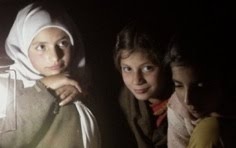 Many Sufi stories and poems try to show that the only real wealth a person can have is their knowledge and wisdom. The Sufi student seeks to have her or his eyes opened to truth in whatever form it arises. Sometimes for this, a self-evident truth needs to be questioned.
Many Sufi stories and poems try to show that the only real wealth a person can have is their knowledge and wisdom. The Sufi student seeks to have her or his eyes opened to truth in whatever form it arises. Sometimes for this, a self-evident truth needs to be questioned.The way of the Sufi is not to get trapped into believing that one religion or philosophy is the truth but to develop an openness which frees you to be able to reconcile opposing and seemingly contradictory ideas. Often, rather than lectures driving home ‘a point’ stories such as this one were told to make us ‘open up’ to such a learning.
There once was king who had two sons.
As they grew up, the first prince helped the people by working for them in a manner they understood; he built good roads and bridges, he opened more schools. The second prince was considered the lazy prince; he was a dreamer, and did not seem to ‘do’ very much. The first son gained great popularity in the kingdom, while the second, who was known to have obtained a wooden horse from a humble carpenter that he sat astride it most of the time, was ignored and even ridiculed.
Actually, this horse was a magical one; it could carry the rider, if he was sincere, to his heart's desire. In search his heart's desire, the young prince suddenly disappeared one day on his horse. He was away for a long, long time. One day, he just as suddenly returned with a beautiful princess from the Country of Light, and his father was overjoyed at his safe return and listened carefully as he recounted is many adventures and the amazing story of the magic horse.
The horse was then made available to anyone in that country who wanted it. But the people preferred the more concrete benefits which the first prince provided for them; though they half-believed the king, the horse to them always looked like a plaything.
When the old king died, by his surprising decree, the prince ‘who played with toys' became the king. But people in the kingdom continued to resent him; they much preferred the discoveries and activities of the practical prince.
Many of these stories and poems teach us to be cautious of a world defined and separated by ‘this’ and ‘that’, specially by labels of ‘right’ and ‘wrong’. A translation of a poem by Jalaluddin Rumi goes:
Out,
beyond ideas of wrong-doing and right-doing,
there is a field.
I’ll meet you there.
Sufis have traditionally spoken of the development in a person of an organ of perception, which, once developed, allows a person to apply himself or herself more completely and effectively to life. And this development is often achieved through a "soaking" in story and poetry, that bypass our rational, give-me-the-one-right-answer mind, allowing our intuitive capacities to recognize the once-hidden but now revealed meanings within them. This might happen consciously or unconsciously, depending on the level of one's awakening.
In the form they are given, most such stories are perfectly suitable as children's stories, though young as well as older people like them. Most people stop there. Some go further, and appreciate their wry humor and entertainment value, perhaps seeing their neighbors or co-workers' behavior exemplified by some characters. Most of those stop there. Some are able to see their own behaviors and attitudes reflected in the stories. But these stories have far more to offer; they lead us to our True Self.
Sufi teaching recognizes that we have an essential nature that is spiritual, and that we are on an earthly journey in order to uncover this essential self. Stories act as powerful teachers on this journey.
Insight or recognition that is gifted to us by story can work to dislodge the comfortable structure that supports our habitual patterns of behavior, responses and comprehension, which often obscure insight into our True Nature. It is believed that the potential for transformation of the self is placed within us; however it is not usually accessible to us because of our limited perception and identification with our everyday and surface self.
Sufism tries to show us that what we think is important may be just a partial understanding of reality. A change in perception that some stories can open us to is often needed to shake us and awaken us to new ways of seeing, new ways of being. Through this, we are closer to becoming the 'completed' person who has seen the heart of truth, and from this vantage point is able to discern the vanities and blinkered vision of others, and more importantly, of oneself.
This is best revealed in the words of the mystic Bayazid Bastami:
I was a revolutionary when I was young, and all my prayer to God was: “Lord, give me the energy to change the world”. As I approached middle age and realized that half my life was gone without my changing a single soul, I changed my prayer to “Lord, give me the grace to change all those who come in contact with me. Just my family and friends, and I shall be content.” Now that I am an old man and my days are numbered, my one prayer is, “Lord, give me the grace to change myself". If I had prayed for this right from the start I would not have wasted my life.
May Story open you to your True Nature.
Marguerite Theophil
Doorway to the Interior
The key to learning from a story is to find
a doorway to its interior.
~ Michael Meade










